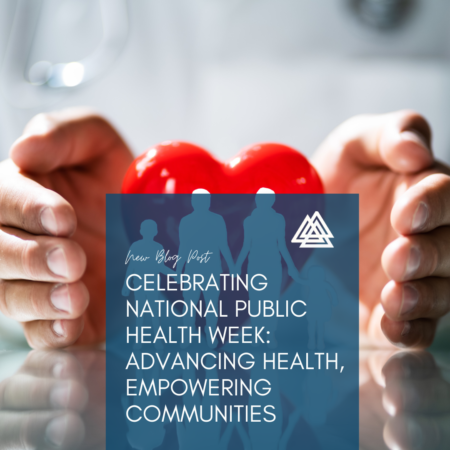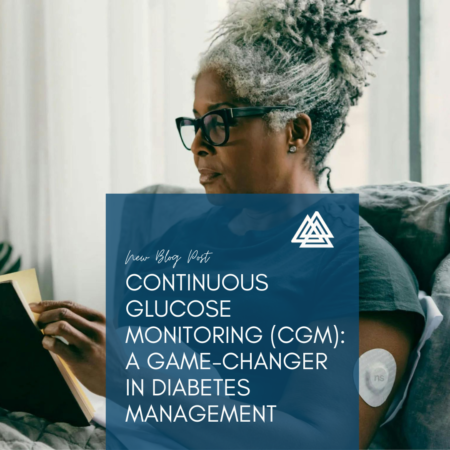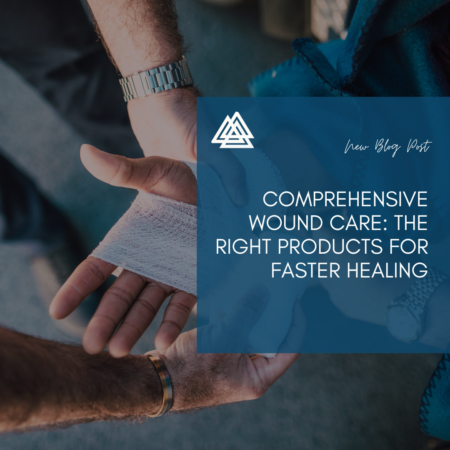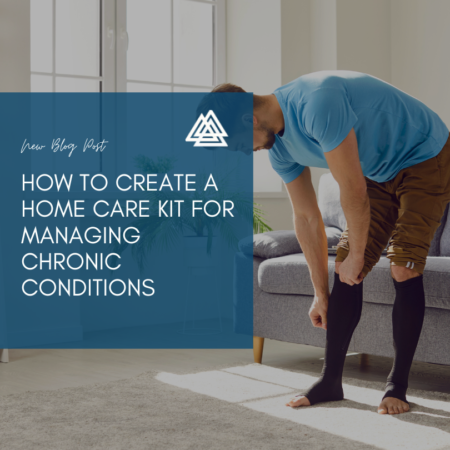Prism Post
 As National Public Health Week closely approaches, the team at Prism would like to emphasize our belief that public health is the foundation of a thriving community. This National Public Health Week, we join the American Public Health Association (APHA) in honoring the dedication of public health professionals and raising awareness of the issues that affect the well-being of individuals and communities across the country.
As National Public Health Week closely approaches, the team at Prism would like to emphasize our belief that public health is the foundation of a thriving community. This National Public Health Week, we join the American Public Health Association (APHA) in honoring the dedication of public health professionals and raising awareness of the issues that affect the well-being of individuals and communities across the country.
This year’s National Public Health Week theme, “Protecting Health, Advancing Equity,” is a powerful reminder that health is not just about treating illness—it’s about preventing disease, promoting healthy lifestyles, and ensuring access to essential resources for all.
Why Public Health Matters
Public health touches every aspect of our lives—from clean water and safe food to mental health support, nutrition access, and disease prevention. It works behind the scenes to reduce health disparities, prevent chronic conditions, and respond to emerging challenges like pandemics and climate-related health issues.
As a trusted provider of nutritional and wellness solutions, Prism proudly supports public health initiatives through:
✅ Accessible, high-quality nutritional supplements
✅ Support for patients managing chronic conditions
✅ Education and tools to empower healthier daily choices
✅ Products that align with the unique needs of vulnerable populations
Our Commitment to Health Equity
We recognize that not all communities have equal access to healthcare, nutrition, and wellness support. That’s why Prism is committed to providing inclusive, patient-centered solutions that help bridge the gap and ensure no one is left behind when it comes to achieving better health.
How You Can Get Involved
Here are a few ways to participate in National Public Health Week:
– Educate yourself and others on key public health topics
– Support local public health initiatives in your community
– Encourage healthy habits at home and in the workplace
– Explore tools and resources that promote wellness for all
– Explore Nutritional Products That Support Public Health Goals
From vitamins and protein supplements to bladder health and digestive support, our lineup at www.onebyprism.com is designed to support individual wellness and promote long-term health for diverse populations.
This week—and every week—let’s work together to build a stronger, healthier future for everyone.
Because public health is all of us.
#NationalPublicHealthWeek #PrismCares #PublicHealthMatters #HealthEquity #WellnessForAll #OneByPrism
 For individuals living with diabetes, managing blood sugar levels is a daily challenge. Traditional fingerstick testing provides snapshots of glucose levels, but what if you could see real-time trends, patterns, and fluctuations? Enter Continuous Glucose Monitoring (CGM)—a revolutionary technology that is transforming diabetes management and empowering users with real-time insights into their blood sugar levels.
For individuals living with diabetes, managing blood sugar levels is a daily challenge. Traditional fingerstick testing provides snapshots of glucose levels, but what if you could see real-time trends, patterns, and fluctuations? Enter Continuous Glucose Monitoring (CGM)—a revolutionary technology that is transforming diabetes management and empowering users with real-time insights into their blood sugar levels.
At Prism, we understand the importance of effective diabetes management and offer a variety of solutions to help individuals monitor and control their glucose levels with ease.
What is a Continuous Glucose Monitor (CGM)?
A CGM is a wearable device that continuously tracks glucose levels throughout the day and night, providing users with real-time data and alerts for better diabetes control. Unlike traditional blood glucose meters that require a fingerstick test, CGMs use a small sensor placed under the skin to measure interstitial glucose levels every few minutes.
How Does a CGM Work?
✔ A tiny sensor is inserted under the skin, usually on the abdomen or upper arm.
✔ The sensor measures glucose levels in the fluid between the cells.
✔ A transmitter sends real-time data to a smartphone or dedicated CGM receiver.
✔ Users can track trends, receive alerts, and adjust their treatment based on continuous readings.
Benefits of Using a CGM
1. Real-Time Glucose Monitoring
Unlike fingersticks, which provide a single moment in time, CGMs allow users to see trends, fluctuations, and patterns in their blood sugar levels 24/7.
2. Fewer Fingersticks
Many CGM devices reduce or eliminate the need for frequent fingerstick tests, making glucose monitoring more convenient and less painful.
3. Alerts & Hypoglycemia Prevention
CGMs alert users to high and low glucose levels in real time, helping to prevent dangerous highs (hyperglycemia) and lows (hypoglycemia) before they become serious.
4. Better Diabetes Management & A1C Control
By tracking glucose trends over time, individuals and healthcare providers can make more informed decisions about insulin dosing, meal planning, and lifestyle adjustments—leading to better overall blood sugar control and improved A1C levels.
5. Improved Quality of Life
With continuous glucose monitoring, individuals can sleep better, exercise with confidence, and reduce stress related to unexpected blood sugar fluctuations.
Who Can Benefit from a CGM?
✔ People with Type 1 Diabetes – CGMs help with insulin dosing, especially for those using insulin pumps or multiple daily injections.
✔ People with Type 2 Diabetes – CGMs provide insights for those managing diabetes with or without insulin.
✔ Individuals at Risk for Hypoglycemia – Real-time alerts help prevent dangerous low blood sugar episodes.
✔ Parents & Caregivers – Some CGMs allow remote monitoring, offering peace of mind for caregivers of children or elderly individuals with diabetes.
Prism’s Commitment to Diabetes Care
At Prism, we offer a range of diabetes management solutions, including CGMs, test strips, lancets, and insulin delivery supplies. Our goal is to provide individuals with the tools they need to manage their blood sugar levels effectively and confidently.
💡 Interested in learning more about CGMs? Contact Prism today to explore our diabetes management products and discover how CGM technology can improve your daily routine.
 Wound healing is a delicate process that requires proper care, the right products, and ongoing attention to prevent infection and promote recovery. Whether you’re managing surgical wounds, pressure ulcers, diabetic foot ulcers, burns, or everyday cuts and scrapes, choosing the right wound care solutions can make all the difference in healing time and comfort.
Wound healing is a delicate process that requires proper care, the right products, and ongoing attention to prevent infection and promote recovery. Whether you’re managing surgical wounds, pressure ulcers, diabetic foot ulcers, burns, or everyday cuts and scrapes, choosing the right wound care solutions can make all the difference in healing time and comfort.
At Prism, we offer a comprehensive range of advanced wound care products, including dressings, bandages, gauze, gels, and medical supplies, designed to support every stage of the healing process.
Understanding the Wound Healing Process
The body heals wounds through a series of stages, and each stage requires different types of care:
1️⃣ Hemostasis – The body stops the bleeding by forming a clot.
2️⃣ Inflammation – White blood cells fight infection and remove damaged tissue.
3️⃣ Proliferation – New tissue forms, and the wound begins to close.
4️⃣ Remodeling/Maturation – The wound fully heals, and scar tissue strengthens.
Using the right wound care products at each stage helps to prevent complications, minimize pain, and promote faster recovery.
Choosing the Right Wound Care Products
1. Wound Dressings: Protecting & Promoting Healing
Selecting the correct dressing is crucial for moisture balance, infection prevention, and optimal healing.
✔ Hydrocolloid Dressings – Ideal for light to moderate wounds, these dressings seal out bacteria while maintaining a moist environment to promote healing.
✔ Foam Dressings – Absorb excess fluid while keeping the wound moist, making them great for moderate to heavily draining wounds.
✔ Alginate Dressings – Made from seaweed-derived fibers, these dressings are perfect for highly exudating wounds and help with faster healing.
✔ Transparent Film Dressings – Provide a protective barrier while allowing easy monitoring of the wound without removal.
2. Bandages & Gauze: Essential Wound Protection
Bandages and gauze are critical components of any wound care routine, providing absorption, protection, and stabilization.
✔ Sterile Gauze Pads & Rolls – Used for cleaning, dressing, and protecting wounds of all sizes.
✔ Compression Bandages – Support circulation, reduce swelling, and help control bleeding for post-surgical wounds or chronic conditions like venous ulcers.
✔ Adhesive Bandages – Perfect for minor cuts, scrapes, and abrasions, offering a convenient and effective barrier against dirt and bacteria.
3. Antimicrobial Wound Care: Preventing Infection
One of the biggest risks in wound healing is infection, which can delay recovery and lead to serious complications. Prism offers a variety of antimicrobial solutions to protect wounds and speed up healing.
✔ Silver-Infused Dressings – Combat bacterial growth while providing a moist healing environment.
✔ Hydrogel Wound Dressings – Help rehydrate dry wounds, reduce pain, and promote faster healing.
✔ Medical-Grade Honey Dressings – Naturally antibacterial, honey dressings help reduce infection and inflammation while soothing the wound.
4. Wound Cleansers & Topical Treatments
Keeping a wound clean and free of debris is essential for proper healing. Prism provides a full range of wound cleansers and skin protectants to support recovery.
✔ Saline Wound Cleansers – Gently flush out debris without irritating the wound.
✔ Antiseptic Solutions – Kill bacteria and help prevent infections in high-risk wounds.
✔ Barrier Creams & Skin Protectants – Prevent moisture-related skin damage, especially for patients at risk of pressure ulcers.
The Importance of a Personalized Wound Care Plan
Every wound is unique, and the best approach depends on the wound type, location, and healing stage. Working with healthcare professionals and using high-quality wound care products ensures optimal recovery with minimal complications.
At Prism, we are dedicated to providing advanced wound care solutions that meet the needs of patients, caregivers, and healthcare providers. Whether you’re treating a minor injury or managing a complex chronic wound, our comprehensive selection of dressings, bandages, and antimicrobial treatments ensures you have the best tools for effective healing.
💡 Looking for reliable wound care products? Contact Prism today to explore our full range of wound care solutions and find the right products for your needs.
 Every year on the second Thursday of March, the world comes together to recognize World Kidney Day, an initiative dedicated to raising awareness about kidney health, disease prevention, and access to care. Your kidneys play a critical role in overall health, and taking steps to protect them can help prevent chronic kidney disease (CKD) and other complications.
Every year on the second Thursday of March, the world comes together to recognize World Kidney Day, an initiative dedicated to raising awareness about kidney health, disease prevention, and access to care. Your kidneys play a critical role in overall health, and taking steps to protect them can help prevent chronic kidney disease (CKD) and other complications.
Why Kidney Health Matters
Your kidneys are responsible for:
✔ Filtering waste and excess fluids from the blood
✔ Regulating blood pressure
✔ Balancing electrolytes and essential nutrients
✔ Producing hormones that support red blood cell production and bone health
When kidneys aren’t functioning properly, waste and toxins can build up in the body, leading to serious health problems like high blood pressure, diabetes complications, and kidney failure.
Understanding Chronic Kidney Disease (CKD)
CKD affects 1 in 7 adults in the U.S., but many people don’t realize they have it until it’s in advanced stages. Early detection and proper management can slow progression and prevent complications.
Signs & Symptoms of CKD:
✔ Fatigue and weakness
✔ Swelling in the legs, ankles, or feet
✔ Frequent urination, especially at night
✔ Difficulty concentrating
✔ Persistent high blood pressure
How to Protect Your Kidney Health
The good news is that kidney disease is often preventable with the right lifestyle choices. Here are some simple steps you can take to support kidney health:
✅ Stay Hydrated – Drink plenty of water to help your kidneys flush out toxins.
✅ Maintain a Balanced Diet – Focus on kidney-friendly foods, such as fresh fruits, vegetables, lean proteins, and whole grains. Avoid excessive salt, sugar, and processed foods.
✅ Control Blood Pressure & Blood Sugar – High blood pressure and diabetes are the leading causes of kidney disease. Managing these conditions with a healthy lifestyle and medications (if needed) can help protect your kidneys.
✅ Exercise Regularly – Physical activity helps maintain a healthy weight, reduces blood pressure, and improves overall kidney function.
✅ Avoid Overuse of Pain Medications – Frequent use of NSAIDs (like ibuprofen) can harm kidney function over time.
✅ Monitor Your Kidney Function – If you have risk factors like diabetes, high blood pressure, or a family history of kidney disease, regular kidney screenings can help detect issues early.
The Role of Protein in Kidney Health
Protein plays a key role in muscle maintenance, immune function, and healing, but for those with kidney disease, moderation is key. Excess protein can put extra strain on the kidneys, so it’s important to choose the right type and amount of protein based on your health needs.
At Prism, we provide high-quality protein supplements, including LPS® Sugar-Free Liquid Protein, that support muscle health while being easy to digest—a great option for those who need to monitor their protein intake while still getting essential nutrients.
Join Us in Spreading Awareness for World Kidney Day World Kidney Day is a global effort to promote kidney health and encourage people to take proactive steps toward prevention. Whether you or a loved one is at risk, now is the time to prioritize kidney care and make small changes that can lead to a healthier future.
Looking for nutritional support for kidney health? Contact Prism today to learn more about protein solutions and how they can support your well-being.
 What is Lymphedema?
What is Lymphedema?
Lymphedema is a chronic condition caused by a buildup of lymph fluid, leading to swelling in the arms, legs, or other parts of the body. This occurs when the lymphatic system is damaged or blocked, often due to cancer treatments, surgery, trauma, or genetic conditions. While there is no cure, proper management can significantly improve quality of life.
Recognizing the Signs of Lymphedema
Early detection is key to preventing complications. Common symptoms include:
✔ Swelling in one or more limbs
✔ A feeling of heaviness or tightness in the affected area
✔ Reduced flexibility or range of motion
✔ Skin changes, such as thickening or hardening
✔ Discomfort or aching in the swollen area
Managing Lymphedema with Compression Therapy
One of the most effective ways to manage lymphedema is through compression therapy, which helps reduce swelling, improve circulation, and prevent fluid buildup.
✔ Compression Garments – Sleeves, gloves, or stockings provide gentle pressure to encourage fluid drainage.
✔ Pneumatic Compression Pumps – These devices offer intermittent compression, helping move lymph fluid effectively.
✔ Bandaging & Wrapping – Multi-layer compression bandaging supports fluid movement and prevents swelling from worsening.
At Prism, we offer a range of high-quality compression solutions designed to provide optimal support and comfort for those managing lymphedema.
Other Ways to Support Lymphedema Management
✔ Exercise & Movement – Gentle exercises, like walking and yoga, help stimulate lymphatic flow.
✔ Skin Care – Keeping the skin clean and moisturized reduces the risk of infections.
✔ Healthy Diet – Reducing sodium intake and staying hydrated can help manage swelling.
Spreading Awareness & Supporting the Lymphedema Community
Lymphedema Awareness Month is a time to educate, advocate, and support those living with this condition. Whether you’re managing lymphedema yourself or supporting a loved one, raising awareness can lead to better resources, treatments, and care.
If you or someone you know is looking for compression solutions to manage lymphedema, Prism is here to help. Contact us today to learn more about the products we offer and find the right support for your needs.
 5 Tips for Supporting Mental and Physical Wellness
5 Tips for Supporting Mental and Physical Wellness
1. Practice Mindful Breathing
Mindful breathing can reduce stress and improve your mental clarity.
How-To: Take a few minutes each day to focus on slow, deep breaths. Inhale for four seconds, hold for four, and exhale for six.
Quick Relief: This technique helps calm your nervous system, making it a great tool during stressful moments.
2. Stay Physically Active
Regular physical activity not only benefits your body but also releases endorphins, the “feel-good” chemicals in your brain.
Low-Impact Options: Yoga, walking, or gentle stretching are excellent ways to stay active without straining your body.
For Prism Customers: If you’re managing conditions like lymphedema or wound care, consult your healthcare provider for activity recommendations tailored to your needs.
3. Build a Routine
A structured daily routine can provide a sense of stability and reduce feelings of overwhelm.
Self-Care Time: Dedicate time each day for self-care, whether it’s journaling, reading, or using your favorite wellness products.
Consistency Matters: Regular routines help reinforce positive habits for both mental and physical health.
4. Connect with Others
Social support is crucial for mental health, especially if you’re managing a chronic condition.
Join a Community: Online or in-person support groups can connect you with others who share similar experiences.
Reach Out: Stay in touch with family and friends, even if it’s just a quick phone call or text.
5. Incorporate Relaxation into Your Day
Relaxation techniques can lower stress levels and improve your overall mood.
Try This: Meditation, progressive muscle relaxation, or even enjoying a warm bath can help you unwind.
Prism Solutions: Consider using skin care products from Prism to make your self-care routine even more soothing.
How Prism Supports Your Whole Self
At Prism, we believe wellness goes beyond physical health. Our range of products—from diabetic socks to skin care solutions—are designed to help you feel your best, inside and out. By addressing both physical and mental well-being, you can take steps toward a happier, healthier you.
You Deserve to Thrive
Managing your mental health is just as important as caring for your body. By making small, consistent changes to support your mental well-being, you’ll feel more empowered to take on life’s challenges—no matter what they may be.
Explore more tips and helpful solutions here.
 Lymphedema is a chronic condition that affects millions of people worldwide, often resulting in swelling and discomfort due to a build-up of lymphatic fluid. While it can be a challenging condition to manage, the right knowledge, tools, and support can make a world of difference in improving your quality of life.
Lymphedema is a chronic condition that affects millions of people worldwide, often resulting in swelling and discomfort due to a build-up of lymphatic fluid. While it can be a challenging condition to manage, the right knowledge, tools, and support can make a world of difference in improving your quality of life.
At Prism, we understand the unique needs of individuals living with lymphedema and are committed to offering solutions that provide comfort, relief, and confidence. Whether you’ve been recently diagnosed or have been managing the condition for years, here’s what you need to know about lymphedema and how to take control of your care.
What is Lymphedema?
Lymphedema occurs when the lymphatic system is damaged or blocked, preventing lymph fluid from draining properly. This results in swelling, typically in the arms, legs, or other affected areas.
Primary Lymphedema: Caused by genetic conditions affecting the lymphatic system.
Secondary Lymphedema: Often results from surgery, cancer treatment, infection, or injury.
Common symptoms of Lymphedema include:
Swelling in the limbs or other areas of the body
Heaviness or tightness in the affected area
Reduced mobility or flexibility
Skin changes, such as thickening or hardening
Discomfort or aching
If you notice these symptoms, consult your healthcare provider for a diagnosis and personalized care plan.
Tips for Managing Lymphedema
1. Wear Compression Garments
Compression therapy is one of the most effective ways to manage lymphedema.
How it Helps: Compression garments, such as sleeves or stockings, provide gentle pressure to help move lymph fluid and reduce swelling.
Prism’s Solution: Our high-quality compression garments are designed for comfort, durability, and effectiveness, making it easier to incorporate into your daily routine.
2. Practice Good Skin Care
Lymphedema can make your skin more vulnerable to infection, so it’s important to keep it clean and hydrated.
Daily Care: Gently wash and dry your skin, paying close attention to folds and creases.
Moisturize: Use a fragrance-free moisturizer to prevent dryness and cracking. Prism offers skin care solutions formulated for sensitive and compromised skin.
3. Stay Active
Regular movement helps stimulate lymph flow and reduce swelling.
Low-Impact Activities: Walking, swimming, yoga, and stretching are great options for improving circulation without overexertion.
Tip: Consult your healthcare provider before starting a new exercise routine to ensure it’s safe for your condition.
4. Elevate the Affected Area
Elevating the swollen area above heart level can help drain lymph fluid and reduce swelling.
Best Practice: Use pillows or supports while sitting or lying down for added comfort and effectiveness.
5. Seek Lymphedema Therapy
Lymphedema specialists can provide manual lymphatic drainage (MLD), a gentle massage technique that helps stimulate the lymphatic system.
Combine with Compression: MLD is often paired with compression therapy for optimal results.
How Prism Supports Your Lymphedema Journey
At Prism, we are committed to making lymphedema management easier and more effective. Our range of products includes:
Compression Garments: High-quality sleeves, stockings, and wraps to reduce swelling and improve circulation.
Skin Care Products: Formulated to keep your skin healthy, moisturized, and protected from infections.
Wellness Solutions: From low-impact exercise aids to ergonomic supports, we offer tools to help you stay active and comfortable.
Embrace Life with Confidence
While living with lymphedema comes with challenges, it’s possible to take control of your condition and improve your quality of life with the right care and resources. Remember, you’re not alone on this journey. With support from your healthcare provider and products tailored to your needs, you can manage lymphedema effectively and embrace every day with confidence.
Discover Prism’s Lymphedema Care Solutions here and take the first step toward a healthier, more comfortable you!
 Adjusting to life with an ostomy can feel overwhelming at first, but with the right tools, knowledge, and mindset, you can live confidently and comfortably. Caring for your ostomy is about more than just the physical—it’s about building confidence in your daily routine and embracing the freedom to live life to the fullest.
Adjusting to life with an ostomy can feel overwhelming at first, but with the right tools, knowledge, and mindset, you can live confidently and comfortably. Caring for your ostomy is about more than just the physical—it’s about building confidence in your daily routine and embracing the freedom to live life to the fullest.
At Prism, we’re dedicated to supporting your ostomy care journey with high-quality products and helpful tips to make everyday life easier. Here’s how you can care for your ostomy while staying confident and comfortable—no matter the season.
1. Prioritize Skincare Around the Stoma
The skin around your stoma is delicate and requires special care to stay healthy and irritation-free.
Cleanse Gently: Use warm water and a soft cloth or wipes designed for ostomy care to clean the skin around your stoma. Avoid harsh soaps or those with fragrances, which can cause irritation.
Protect Your Skin: Apply a barrier cream or skin protectant to create a protective layer between your skin and the adhesive on your ostomy pouch. This helps prevent redness and soreness.
Monitor for Issues: Regularly check your skin for any signs of irritation, rashes, or infections. If you notice persistent issues, consult your healthcare provider for advice.
2. Choose the Right Ostomy Supplies
Having the right supplies can make all the difference in your comfort and confidence.
Leak-Proof Pouches: Ensure your pouch has a secure, leak-proof seal to provide peace of mind throughout your day. Prism offers a range of high-quality ostomy pouches tailored to your needs.
Comfortable Adhesives: Look for adhesive wafers that are gentle on your skin but provide a strong hold, even during physical activity.
Odor Control: Many modern ostomy pouches feature built-in filters to control odors discreetly.
Clothing Choices: Opt for ostomy wraps or belts for added support and security, especially during physical activity or while layering clothes in colder weather.
3. Stay Active and Embrace Daily Life
Living with an ostomy doesn’t mean giving up the things you love. With a little preparation, you can continue your favorite activities with confidence.
Winter Layering Tips: During colder months, layer lightly around your ostomy to avoid excess pressure while keeping warm. Choose loose-fitting, breathable fabrics to stay comfortable.
Exercise Comfortably: Whether you enjoy yoga, walking, or other forms of exercise, use a supportive ostomy belt for added security. Start slow and listen to your body.
Plan Ahead for Travel: Carry a small travel kit with extra ostomy supplies, cleaning wipes, and a change of clothes for peace of mind on the go.
4. Build Confidence in Your Routine
Confidence starts with feeling prepared and supported.
Establish a Routine: Regularly empty and change your pouch to avoid discomfort or accidents. Over time, this will become a natural part of your daily life.
Connect with Support Networks: Joining an ostomy support group or talking to others with similar experiences can provide reassurance and practical advice.
Rely on Trusted Products: Prism’s ostomy care solutions are designed to help you feel your best, with products that focus on comfort, reliability, and ease of use.
5. Take Extra Steps During Winter
Cold weather can pose unique challenges for ostomy care, but small adjustments can keep you comfortable.
Stay Hydrated: Winter air can be drying, so drink plenty of water to stay hydrated and prevent skin irritation.
Protect Your Skin: Use moisturizers around the stoma area, but avoid applying them directly to the adhesive zone.
Prepare for Outdoor Activities: If you’re spending time outdoors, wear a protective layer over your ostomy pouch to shield it from extreme cold and ensure a secure fit.
Feel Supported with Prism’s Ostomy Care Products
At Prism, we’re committed to empowering individuals with ostomies to live confidently and comfortably. From leak-proof pouches to skin-friendly adhesives and support belts, our range of ostomy care solutions is designed to make your daily routine easier and stress-free.
Living with an ostomy doesn’t mean compromising your lifestyle. By prioritizing your comfort and finding the right tools, you can embrace every moment with confidence and ease. Find more ostomy care tips and access to products here.
 Valentine’s Day is a time to celebrate love—not just for your partner, family, or friends, but also for yourself and your health. For individuals managing diabetes, February is the perfect opportunity to focus on heart health and self-care while still enjoying the sweetness of the season. With a little planning and thoughtful choices, you can celebrate a love-filled Valentine’s Day without compromising your health goals. Here are some tips to keep your heart and blood sugar levels in check this month.
Valentine’s Day is a time to celebrate love—not just for your partner, family, or friends, but also for yourself and your health. For individuals managing diabetes, February is the perfect opportunity to focus on heart health and self-care while still enjoying the sweetness of the season. With a little planning and thoughtful choices, you can celebrate a love-filled Valentine’s Day without compromising your health goals. Here are some tips to keep your heart and blood sugar levels in check this month.
1. Choose Smart Food Options
Valentine’s Day often means indulging in chocolates, sweets, and romantic dinners, but managing diabetes doesn’t mean missing out.
Opt for Dark Chocolate: If you want to indulge, go for a small portion of dark chocolate (70% cocoa or higher), which is lower in sugar and contains heart-healthy antioxidants.
Plan Balanced Meals: Focus on lean proteins, healthy fats, and non-starchy vegetables. Add a small portion of whole grains or legumes for a heart-healthy carbohydrate option.
Avoid Hidden Sugars: Be mindful of sauces, dressings, and beverages that can contain added sugars. Instead, opt for homemade versions with natural, sugar-free ingredients.
2. Stay Active Together
Use Valentine’s Day as an opportunity to get moving and stay active with your loved ones. Exercise is great for managing blood sugar levels and promoting heart health.
Take a Romantic Walk: A brisk walk after a meal can help regulate blood sugar and aid digestion.
Dance It Out: Whether you’re at a Valentine’s party or at home, dancing is a fun way to bond and get your heart rate up.
Try a New Activity: Yoga, cycling, or even a virtual fitness class can be a great way to stay active while spending quality time together.
3. Monitor Blood Sugar Levels Regularly
With special meals and celebrations, it’s important to keep track of your blood sugar levels to avoid unexpected spikes or dips.
Use a Reliable Glucose Monitor: Prism offers glucose monitoring supplies to help you stay on top of your numbers with ease. Check before and after meals to understand how different foods affect your blood sugar.
Keep Snacks Handy: Always carry a small snack like nuts or a glucose tablet in case your blood sugar drops unexpectedly.
4. Prioritize Comfort and Care
For individuals managing diabetes, comfort and proper care go hand in hand with good health.
Wear Diabetic Socks: Prism’s diabetic socks are designed to provide comfort, promote circulation, and reduce the risk of irritation or sores. They’re perfect for keeping your feet cozy during winter walks.
Moisturize Your Skin: Winter weather can cause dry, cracked skin, which is especially problematic for individuals with diabetes. Use a gentle, fragrance-free moisturizer to keep your skin healthy.
5. Practice Self-Love and Stress Management
Valentine’s Day can sometimes bring stress, whether from planning the perfect day or managing blood sugar amidst celebrations. Take time for yourself:
Meditate or Relax: Spend a few minutes practicing deep breathing or meditation to lower stress levels.
Treat Yourself: Whether it’s a good book, a warm bath, or a cozy evening at home, prioritize activities that bring you joy and relaxation.
Celebrate with Prism’s Support
At Prism, we’re here to help you make the most of your Valentine’s Day while staying on track with your health goals. From diabetic socks to glucose monitoring supplies, our products are designed to support your diabetes management and overall wellness.
This February, let’s celebrate love—love for your health, love for your heart, and love for a life well-lived. Cheers to a happy, healthy Valentine’s Day! Find more helpful tips.
 Managing a chronic condition like diabetes, lymphedema, or mobility challenges requires preparation and access to the right tools at home. Having a well-stocked home care kit can make managing daily needs easier and provide peace of mind for both patients and caregivers. Here’s a comprehensive checklist to help you create your own home care kit tailored to your specific needs.
Managing a chronic condition like diabetes, lymphedema, or mobility challenges requires preparation and access to the right tools at home. Having a well-stocked home care kit can make managing daily needs easier and provide peace of mind for both patients and caregivers. Here’s a comprehensive checklist to help you create your own home care kit tailored to your specific needs.
Essentials for Managing Diabetes
Blood Glucose Monitor and Test Strips:
A reliable glucometer to track blood sugar levels accurately.
Lancets and Lancing Device:
For safe and hygienic blood sampling.
Logbook or Digital App:
To track blood sugar readings, diet, and medication schedules.
Fast-Acting Glucose:
Items like glucose tablets or gel to treat hypoglycemia quickly.
Insulin and Syringes/Pens:
If prescribed, ensure you have the necessary supplies and storage (like a cooling case).
Alcohol Swabs:
For cleaning the skin before testing or injecting insulin.
Compression Socks:
To improve circulation and reduce the risk of swelling and foot complications.
Foot Care Tools:
Include a mirror for checking the soles of your feet, a nail clipper, and moisturizing cream to prevent dryness.
Emergency Contact Numbers:
A list of healthcare providers, including your endocrinologist and local pharmacy.
Essentials for Managing Lymphedema
Compression Garments:
Include gradient compression sleeves or stockings to help reduce swelling and improve circulation.
Moisturizing Cream:
To keep skin hydrated and prevent cracking or infections.
Lymphedema Pump (if prescribed):
For at-home therapy to reduce fluid buildup.
Bandages and Wraps:
Used during decongestive therapy to support fluid drainage.
Exercise Equipment:
Resistance bands or light weights for recommended exercises to promote lymphatic flow.
Skincare Supplies:
Antibacterial soap and non-fragranced lotions to protect sensitive skin.
Foam Rollers or Massagers:
To assist with lymphatic drainage and relieve tension.
Cold Packs:
To reduce swelling and provide comfort during flare-ups.
Essentials for Managing Mobility Issues
Walker, Cane, or Crutches:
Ensure mobility aids are properly fitted and in good condition.
Grabber Tool:
For picking up items without straining or bending.
Transfer Bench or Shower Chair:
To ensure safety and comfort during bathing.
Slip-Resistant Mats:
Place them in the bathroom and other high-risk areas to prevent falls.
Supportive Braces:
For knees, wrists, or ankles as recommended by your healthcare provider.
Wheelchair or Scooter (if needed):
Keep it maintained and charged if powered.
Reacher or Dressing Aids:
Tools like sock aids or button hooks to simplify daily dressing.
Pill Organizer:
To keep medications sorted and ensure proper dosing.
General Items for All Chronic Conditions
First Aid Kit:
Include bandages, antiseptic wipes, and gauze for minor injuries.
Blood Pressure Monitor:
For regular tracking of cardiovascular health.
Notebook or Planner:
To track appointments, medication schedules, and daily symptoms.
Hygiene Supplies:
Disposable gloves, hand sanitizer, and disinfecting wipes.
Backup Power Supply:
For essential medical devices in case of a power outage.
Comfort Items:
Include pillows, blankets, or a heating pad for added support and relaxation.
Organizing Your Home Care Kit
Use a Storage System: Keep items in labeled bins or a dedicated cabinet for easy access.
Create a Portable Kit: Use a tote bag or small box for essential items you need on the go.
Review Regularly: Check expiration dates and restock items as needed.
Take Control of Your Health
A well-prepared home care kit can make managing chronic conditions more convenient and less stressful. By having the right tools and supplies on hand, you’ll be ready to address daily needs and respond to potential issues quickly.
Explore Prism range of services and products to support your home care needs at https://www.prism-medical.com. With the right preparation, you can take charge of your health and enjoy greater peace of mind.
